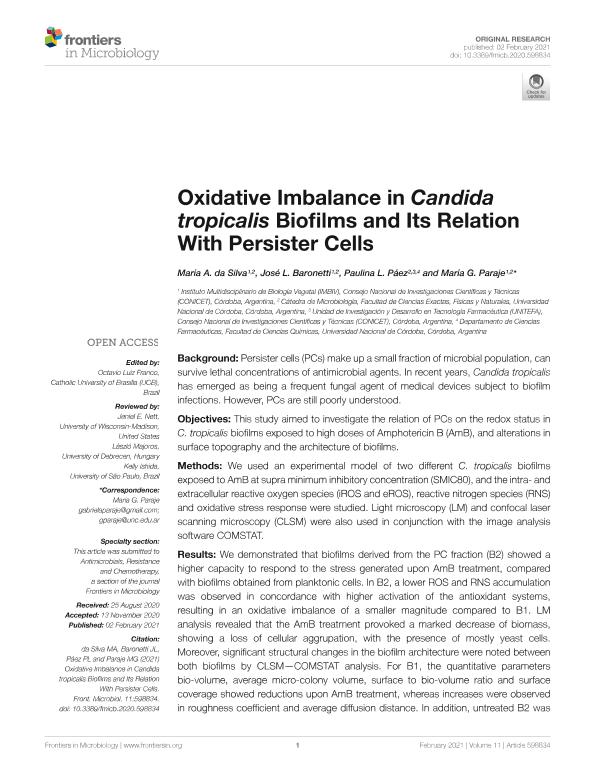Mostrar el registro sencillo del ítem
dc.contributor.author
Da Silva, María Angel

dc.contributor.author
Baronetti, Jose Luis

dc.contributor.author
Páez, Paulina Laura

dc.contributor.author
Paraje, María Gabriela

dc.date.available
2021-07-13T13:04:57Z
dc.date.issued
2021-02
dc.identifier.citation
Da Silva, María Angel; Baronetti, Jose Luis; Páez, Paulina Laura; Paraje, María Gabriela; Oxidative imbalance in Candida tropicalis biofilms and its relation with persister cells; Frontiers Media S.A.; Frontiers in Microbiology; 11; 2-2021; 1-14
dc.identifier.uri
http://hdl.handle.net/11336/135937
dc.description.abstract
Persister cells (PCs) make up a small fraction of microbial population, can survive lethal concentrations of antimicrobial agents. In recent years, Candida tropicalis has emerged as being a frequent fungal agent of medical devices subject to biofilm infections. However, PCs are still poorly understood. This study aimed to investigate the relation of PCs on the redox status in C. tropicalis biofilms exposed to high doses of Amphotericin B (AmB), and alterations in surface topography and the architecture of biofilms. Methods: We used an experimental model of two different C. tropicalis biofilms exposed to AmB at supra minimum inhibitory concentration (SMIC80), and the intra- and extracellular reactive oxygen species (iROS and eROS), reactive nitrogen species (RNS) and oxidative stress response were studied. Light microscopy (LM) and confocal laser scanning microscopy (CLSM) were also used in conjunction with the image analysis software COMSTAT. Results: We demonstrated that biofilms derived from the PC fraction (B2) showed a higher capacity to respond to the stress generated upon AmB treatment, compared with biofilms obtained from planktonic cells. In B2, a lower ROS and RNS accumulation was observed in concordance with higher activation of the antioxidant systems, resulting in an oxidative imbalance of a smaller magnitude compared to B1. LM analysis revealed that the AmB treatment provoked a marked decrease of biomass, showing a loss of cellular aggrupation, with the presence of mostly yeast cells. Moreover, significant structural changes in the biofilm architecture were noted between both biofilms by CLSM?COMSTAT analysis. For B1, the quantitative parameters bio-volume, average micro-colony volume, surface to bio-volume ratio and surface coverage showed reductions upon AmB treatment, whereas increases were observed in roughness coefficient and average diffusion distance. In addition, untreated B2 was substantially smaller than B1, with less biomass and thickness values. The analysis of the above-mentioned parameters also showed changes in B2 upon AmB exposure. Conclusion: To our knowledge, this is the first study that has attempted to correlate PCs of Candida biofilms with alterations in the prooxidant-antioxidant balance and the architecture of the biofilms. The finding of regular and PCs with different cellular stress status may help to solve the puzzle of biofilm resistance, with redox imbalance possibly being an important factor.
dc.format
application/pdf
dc.language.iso
eng
dc.publisher
Frontiers Media S.A.
dc.rights
info:eu-repo/semantics/openAccess
dc.rights.uri
https://creativecommons.org/licenses/by-nc-sa/2.5/ar/
dc.subject
ANTIFUNGALS
dc.subject
BIOFILMS
dc.subject
CANDIDA TROPICALIS
dc.subject
NITROSATIVE STRESS
dc.subject
OXIDATIVE STRESS
dc.subject
PERSISTER CELLS
dc.subject.classification
Biología Celular, Microbiología

dc.subject.classification
Ciencias Biológicas

dc.subject.classification
CIENCIAS NATURALES Y EXACTAS

dc.title
Oxidative imbalance in Candida tropicalis biofilms and its relation with persister cells
dc.type
info:eu-repo/semantics/article
dc.type
info:ar-repo/semantics/artículo
dc.type
info:eu-repo/semantics/publishedVersion
dc.date.updated
2021-07-12T13:30:06Z
dc.identifier.eissn
1664-302X
dc.journal.volume
11
dc.journal.pagination
1-14
dc.journal.pais
Reino Unido

dc.description.fil
Fil: Da Silva, María Angel. Consejo Nacional de Investigaciones Científicas y Técnicas. Centro Científico Tecnológico Conicet - Córdoba. Instituto Multidisciplinario de Biología Vegetal. Universidad Nacional de Córdoba. Facultad de Ciencias Exactas Físicas y Naturales. Instituto Multidisciplinario de Biología Vegetal; Argentina
dc.description.fil
Fil: Baronetti, Jose Luis. Universidad Nacional de Córdoba. Facultad de Ciencias Químicas. Departamento de Farmacia; Argentina. Consejo Nacional de Investigaciones Científicas y Técnicas; Argentina
dc.description.fil
Fil: Páez, Paulina Laura. Consejo Nacional de Investigaciones Científicas y Técnicas. Centro Científico Tecnológico Conicet - Córdoba. Unidad de Investigación y Desarrollo en Tecnología Farmacéutica. Universidad Nacional de Córdoba. Facultad de Ciencias Químicas. Unidad de Investigación y Desarrollo en Tecnología Farmacéutica; Argentina
dc.description.fil
Fil: Paraje, María Gabriela. Consejo Nacional de Investigaciones Científicas y Técnicas. Centro Científico Tecnológico Conicet - Córdoba. Instituto Multidisciplinario de Biología Vegetal. Universidad Nacional de Córdoba. Facultad de Ciencias Exactas Físicas y Naturales. Instituto Multidisciplinario de Biología Vegetal; Argentina
dc.journal.title
Frontiers in Microbiology
dc.relation.alternativeid
info:eu-repo/semantics/altIdentifier/doi/https://doi.org/10.3389/fmicb.2020.598834
dc.relation.alternativeid
info:eu-repo/semantics/altIdentifier/url/https://www.frontiersin.org/articles/10.3389/fmicb.2020.598834/full
Archivos asociados
